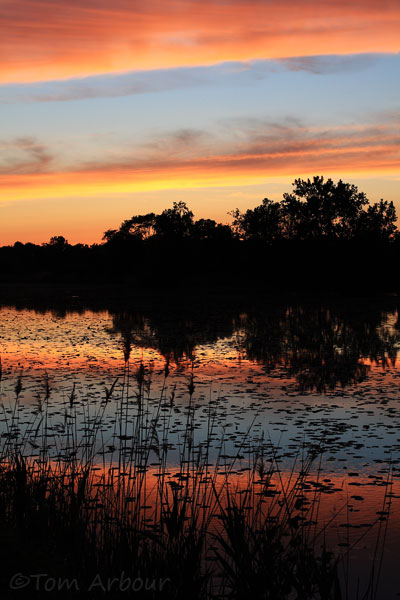
The floating leaved marshes between the mainland and Catawba Island provided for amazing reflective sunsets. I took this image from the parking lot of our hotel.
It's just too bad that the non-native invasive species, that giant grass in the foreground, Phragmites australis subsp. australis, or simply "Phragmites", has become so prevalent along the lakeshore. For more about this nasty plant, you need to watch this video.
There is a native subspecies of Phragmites, Phragmites australis subspecies americanus that isn't invasive, but it is quite rare. I've found it in Lake Erie Marshes and prairie fens further inland.
Tom

Tom: It did make for a beautiful capture of the sunset and the reflection.
ReplyDeleteTom, this is one of the most beautiful views I ever seen. Thanks for sharing. Anna :)
ReplyDelete...the beauitful colors in the reflection combined with the dark silhouettes of the invasives make a stunning photograph. Thanks for the info on the invasives as well...
ReplyDeleteWow, that's a jaw-dropping photograph! Good work!
ReplyDeleteNice photograph and interesting video. It's amazing how these invasive species are super plants. Here we have the asian milfoil that's clogging up the waterways.
ReplyDeleteJohn- We have plenty of Asian Milfoil- It's so bad we're not worried about it- It is probably in every Lake and Reservoir in Ohio.
ReplyDeleteTom
That's a sublime sunset photo. Thank you for putting the word "Phragmites" in writing - the staff at the Wilds mentioned it a couple of times, but I had no idea how to go about spelling it. I will have to come back and check out the video.
ReplyDeleteBeautiful sunset photo! Love the black silhouettes against the firey sky & reflection!
ReplyDeleteThis shot is gorgeous! What neat colors! That grass you showing looks like what I see at Blue Grass when I am there. Sorry to hear it is invasive.
ReplyDeleteMary- It could be the native species where you are- Try to get some pictures if possible and I should be able to tell. Check to see if the plants you are seeing have any red on the stems.
ReplyDeleteTom